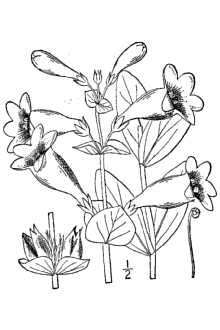Penstemon bradburii Pursh
Scientific Name: Penstemon bradburii Pursh

| General Information | |
|---|---|
| Usda Symbol | PEBR14 |
| Group | Dicot |
| Life Cycle | Perennial |
| Growth Habits | Forb/herb |
| Native Locations | PEBR14 |
Plant Guide
Alternative Names
large-flowered beardtongue, showy beardtongue, pink beardtongue, shell-leaf penstemon, shell-leaf beardtongue, wild foxglove, Canterbury bells
Uses
Ethnobotanic: Native Americans treated toothache by chewing the root pulp of plants in this genus and placing it in the cavity (Runkel & Roosa 1989). The Navajo applied a wet dressing of pounded leaves of large beardtongue to rattlesnake bites; they considered this an absolute antidote (Ibid.). A decoction of the leaves has been used in the treatment of chills and fevers (Moerman 1998).
Status
Please consult the Plants Web site and your State Department of Natural Resources for this plant’s current status, such as, state noxious status, and wetland indicator values. © Kurt Adolfson Native Wildflowers of the North Dakota Grasslands USDI, GS, Northern Prairie Wildlife Research Center
Description
General: Snapdragon family (Scrophulariaceae). Large beardtongue is a native perennial that grows up to four feet tall. The leaves are opposite, simple, ovate to oblong, thick and fleshy; bluish-green with a waxy blue sheen and clasping at the base. The large two inch, pale purple flowers are five lobed and short lived (Runkel & Roosa 1989). The fruits are woody, egg shaped capsules that contain numerous small, angular, brown seeds (Freeman & Schofield 1991). Distribution: Large beardtongue ranges from Wyoming to Texas, east to Wisconsin, Illinois, Missouri and Oklahoma (Steyermark 1963). For current distribution, please consult the Plant profile page for this species on the PLANTS Web site.
Adaptation
Penstemon grandiflorus is commonly found in prairies, often in sandy or loamy soils. This plant prefers acid, neutral and alkaline soils and requires well-drained soils. It grows well when planted in open dry situations (Steyermark 1963), and can grow in semi-shade or no shade.
Establishment
Propagation by Seed: Penstemon grandiflorus seeds are best sown in the fall or spring in a greenhouse (Heuser 1997). The seeds should germinate within one to four months (Ibid.). When the seedlings are large enough to handle, place them into individual pots and plant them out in their permanent positions in the late spring.
Management
Stem tip cuttings should be taken from the tips of healthy, non-flowering, semi-mature or mature shoots, between early summer and fall (Heuser 1997), Shoots can be cut into a number of usable sections at almost any time during the growing period (Ibid,), Cultivars, Improved and Selected Materials (and area of origin) Somewhat available through native plant seed vendors in the Great Plains region, Contact your local Natural Resources Conservation Service (formerly Soil Conservation Service) office for more information, Use soil moisture sensors to measure the soil moisture of Penstemon bradburii Pursh., Look in the phone book under ”United States Government,” The Natural Resources Conservation Service will be listed under the subheading “Department of Agriculture,”
References
Freeman, C.C & E.K. Schofield. 1991. Roadside wildflowers of the southern Great Plains. University Press of Kansas, Lawrence, Kansas. Heuser, C.W. 1997. The complete book of plant propagation. The Taunton Press, Newtown, Connecticut. Huxley, A. 1992. The new RHS dictionary of gardening. MacMillan Press, New York, New York. Ladd, D. 1995. Tallgrass prairie wildflowers: a falcon field guide. Falcon Press Publishing Company, Helena, Montana. Moerman, D. 1998. Native American ethnobotany. Timber Press, Portland, Oregon. Owensby, C.E. 1980. Kansas prairie wildflowers. Iowa State University Press, Ames, Iowa. Runkel, S.T. & D.M. Roosa 1989. Wildflowers of the tallgrass prairie: the upper Midwest. Iowa State University Press, Ames, Iowa. Stamen, T.R. & W.S. Myers 1937. Oklahoma flora. Harlow Publishing Co., Oklahoma City, Oklahoma. Steyermark, J.A. 1963. Flora of Missouri. The Iowa State University Press, Ames, Iowa. The Great Plains Flora Association 1986. Flora of the Great Plains. University Press of Kansas, Lawrence, Kansas.

